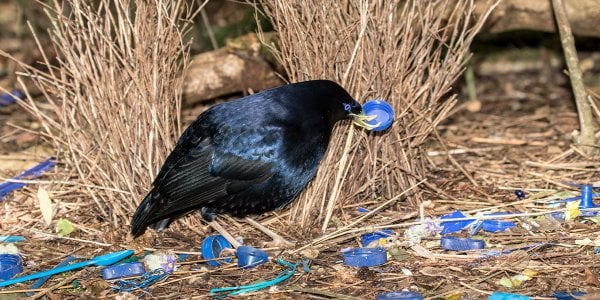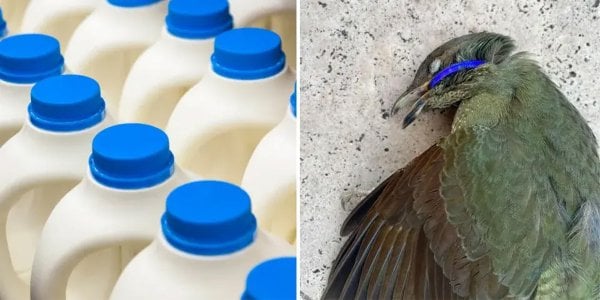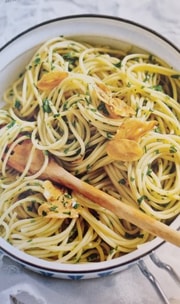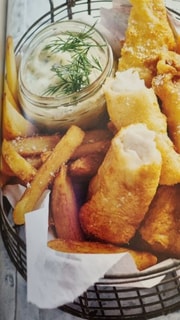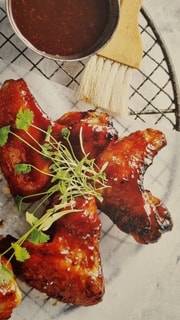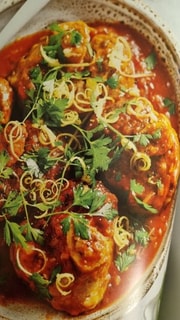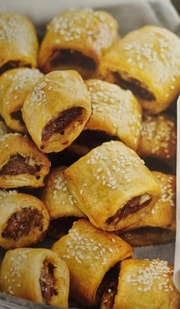The Deadly Truth: How This Everyday Grocery Item is Wiping Out Aussie Wildlife
By
VanessaC
- Replies 4
The Australian native bowerbird is known for its unique courtship behaviour–collecting blue objects to attract its mate. But lately, what the bowerbird is collecting has had devastating effects on its population.
On Saturday, a NSW man found a bowerbird carcass in his backyard with a plastic ring–presumed to be from a milk bottle–stuck in its mouth and wrapped around its head.
In an angry and sad post to Facebook, he wrote: 'A reminder to cut milk bottle cap rings, or leave them in the bottle with the cap on, so they can’t strangle our wildlife.'
Sadly, the bowerbird is just one of many animals being strangled by plastic rubbish each year. According to Megan Fabian from the Australia Wildlife Society, thousands of birds are strangled by these items each year.
'Not only birds, but other vulnerable species too, such as turtles, dolphins, and dugong,' she said. 'It’s something that our native Australian wildlife are especially vulnerable to because they don’t have that much experience with plastic,' she said.
It has become a big problem that the Australia Wildlife Society launched the Snip Rings for Wildlife campaign in 2020 to raise awareness about ring-shaped objects and how they should be disposed of correctly, preferably by snipping them in half, returning them to the bottle, and inserting the bottle cap again.
Coles has made progress in the right direction with its ‘peel and seal’ lids on some of its milk bottles–although they are made of plastic, so merely solving one problem and creating another.
Taking small actions, like cutting up milk bottle caps and being more mindful of how we dispose of rubbish, can help reduce the number of wildlife fatalities caused by plastic entanglement.
Wires CEO Leanne Taylor said, ‘This poor bowerbird is a prime example of how important it is for us to responsibly dispose of all our rubbish, especially near waterways where it can end up on river banks or in reeds and entrap native species such as platypus, turtles and water birds.’
The Facebook post has resulted in an outpour of angry comments about plastic killing wildlife, with many wondering why we still haven’t found a solution. 'We all need to stop buying the milk that has the blue rings! This is a known problem,' one local fumed.
The mounting plastic menace is proving to be a fatal obstruction to Australia's diverse wildlife population.
Marine creatures are also heavily affected by plastic waste. Consuming objects like bottle caps, thinking they're food, only disrupts the animal's internal systems leading to immeasurable suffering and eventual death. Seals, sea lions, and whales are often victims of plastic fishing gear and packaging materials.
The problem is unignorably visible even on Australian shorelines. Studies show that Australia's coasts are densely polluted by plastic litter worldwide, which has become a major environmental concern.
Plastic pollution, unfortunately, is an insidious invader creeping into Australia's ecosystem. It affects terrestrial and marine wildlife, from our cuddly koalas down to the smallest insects.
Insects play a vital role in pollination, but they are not immune to the dire consequences of plastic pollution. Honeybees are accumulating more tiny pieces of plastic in their bodies causing detrimental effects on the insect population.
Thoughtless disposal of plastic waste is cutting lives short and causing irreparable damage to Australia's precious wildlife. However, we hold the power to influence change. A simple change in our daily habits can save countless lives and keep our country wild and beautiful.
 Have you seen anything similar in your area? Share your stories and thoughts with us in the comments below!
Have you seen anything similar in your area? Share your stories and thoughts with us in the comments below!
On Saturday, a NSW man found a bowerbird carcass in his backyard with a plastic ring–presumed to be from a milk bottle–stuck in its mouth and wrapped around its head.
In an angry and sad post to Facebook, he wrote: 'A reminder to cut milk bottle cap rings, or leave them in the bottle with the cap on, so they can’t strangle our wildlife.'
Sadly, the bowerbird is just one of many animals being strangled by plastic rubbish each year. According to Megan Fabian from the Australia Wildlife Society, thousands of birds are strangled by these items each year.
'Not only birds, but other vulnerable species too, such as turtles, dolphins, and dugong,' she said. 'It’s something that our native Australian wildlife are especially vulnerable to because they don’t have that much experience with plastic,' she said.
It has become a big problem that the Australia Wildlife Society launched the Snip Rings for Wildlife campaign in 2020 to raise awareness about ring-shaped objects and how they should be disposed of correctly, preferably by snipping them in half, returning them to the bottle, and inserting the bottle cap again.
Coles has made progress in the right direction with its ‘peel and seal’ lids on some of its milk bottles–although they are made of plastic, so merely solving one problem and creating another.
Taking small actions, like cutting up milk bottle caps and being more mindful of how we dispose of rubbish, can help reduce the number of wildlife fatalities caused by plastic entanglement.
Wires CEO Leanne Taylor said, ‘This poor bowerbird is a prime example of how important it is for us to responsibly dispose of all our rubbish, especially near waterways where it can end up on river banks or in reeds and entrap native species such as platypus, turtles and water birds.’
The Facebook post has resulted in an outpour of angry comments about plastic killing wildlife, with many wondering why we still haven’t found a solution. 'We all need to stop buying the milk that has the blue rings! This is a known problem,' one local fumed.
The mounting plastic menace is proving to be a fatal obstruction to Australia's diverse wildlife population.
Marine creatures are also heavily affected by plastic waste. Consuming objects like bottle caps, thinking they're food, only disrupts the animal's internal systems leading to immeasurable suffering and eventual death. Seals, sea lions, and whales are often victims of plastic fishing gear and packaging materials.
The problem is unignorably visible even on Australian shorelines. Studies show that Australia's coasts are densely polluted by plastic litter worldwide, which has become a major environmental concern.
Plastic pollution, unfortunately, is an insidious invader creeping into Australia's ecosystem. It affects terrestrial and marine wildlife, from our cuddly koalas down to the smallest insects.
Insects play a vital role in pollination, but they are not immune to the dire consequences of plastic pollution. Honeybees are accumulating more tiny pieces of plastic in their bodies causing detrimental effects on the insect population.
Thoughtless disposal of plastic waste is cutting lives short and causing irreparable damage to Australia's precious wildlife. However, we hold the power to influence change. A simple change in our daily habits can save countless lives and keep our country wild and beautiful.
Key Takeaways
- A photo of a deceased bowerbird that became entangled with a plastic ring from a milk bottle has prompted a reminder for people to dispose of rubbish properly.
- Megan Fabian of the Australia Wildlife Society said that thousands of birds are strangled by ring-shaped objects, including milk bottle rings and rubber bands each year.
- The Australia Wildlife Society's 'Snip Rings for Wildlife' campaign aims to raise awareness about the dangers of these items and encourages people to snip through plastic rings before disposing.
- Calls are being made to ban the production of such ring-shaped items, and some manufacturers, like Coles, have now started using 'peel and seal' lids, although these are plastic and pose other environmental concerns.

